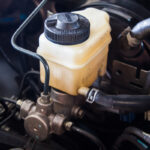
You’re in a hurry to get your auto body sanding done but the tools you have aren’t the right ones for the job. You’ll need something with more power, something with more speed, a smoother finish—something that will help you to complete your task in just half an hour or less. In this blog, I’ll explain some common auto body sanding tools on the market right now.
With that said, let’s take a look at some of the best tools and how they may be able to help you.
Table of Contents
Understanding Auto Body Sanding
Auto body sanding is a process that involves using abrasive materials, such as sandpaper or sanding blocks, to smooth and prepare the surface of a vehicle’s body for paint application. It is an essential step in the paint preparation process for several reasons:
- Surface leveling: Sanding helps level out any imperfections or unevenness on the surface of the vehicle. These imperfections can include scratches, dents, bumps, or other surface irregularities. By sanding the surface, these flaws are smoothed out, creating a more uniform and even surface.
- Paint adhesion: Sanding creates a roughened texture on the surface, which improves the adhesion of the paint. A smooth surface can make it difficult for paint to adhere properly, leading to issues such as peeling or flaking over time. By sanding, the surface is given microscopic grooves that allow the paint to bond effectively, resulting in a more durable and long-lasting finish.
- Removing old paint or coatings: If there are existing layers of paint or other coatings on the vehicle, sanding helps remove them. Sanding down these layers ensures that the new paint adheres directly to the vehicle’s surface rather than to the previous layers, which may be deteriorating or incompatible with the new paint.
- Surface cleanliness: Sanding also helps remove any dirt, debris, or contaminants present on the surface. This is crucial because any foreign particles can interfere with the paint application and result in an uneven or flawed finish. By sanding, these impurities are eliminated, providing a clean and smooth surface for the paint.
Types Of Auto Body Sanding Tools
#1 Belt Sander
A belt sander is similar to a disc sander except that it has a small and thin conveyor belt that rotates at high speeds. They are usually found mounted onto a stand, which causes the sanding belt to move in one direction.
Belt sanders are used to smooth out the surface of auto parts and furniture. It is a fast and easy way to sand, but it may not be tough enough to take heavy-duty scratches and burs off of metals.
Find out: What is the cost to fix your car bumper?!
#2 Random Orbital Sander

A random orbital sander features a round sanding pad that can easily pivot in four directions. It is a handy tool that can sand and polish almost any surface material. It is designed to turn in three directions while rotating at two speeds. They are also ideal for taking off superficial scratches and roughing up the surface of auto parts.
This tool is used in auto body repair shops by professional painters and body men. It is a high-end sanding tool that can be used on cars, boats, trucks, and even airplanes.
#3 Sanding Board
A sanding board is a larger version of the sanding belt used by belt sanders, and it features random orbital motion as well. It’s another tool that’s ideal for auto body repair shops.
It’s used to smooth out the surface of auto parts, furniture, and crafts—any material that needs a little bit more than just a simple hand or power sander can provide. The sanding board is also good for smoothing out complex forms on pieces.
You’ll need sanding papers and a vacuum attachment to work with it.
#4 Foam Sanding Block
Foam sanding blocks are used for carving and smoothing out parts of a car’s body. They look like an upside-down fridge and are designed to allow a person to work in a comfortable position.
The foam is firm enough to maintain an even surface, but it isn’t as hard or rigid as wood or plastic. Foam sanding blocks come in different sizes to provide a wide range of motion.
The advantage of this tool is that it is safe to use on any surface and wood, plastic, and aluminum alike. However, its downside is that it’s not durable.
#5 Abranet Sanding Block
Abranet sanding blocks are handy tools that are designed to support the part being sanded. They come in different sizes, and they are made of rubber and stainless steel.
They can be used for both power and hand sanding on almost any material. However, it’s not as accurate or precise as a powered tool. The advantage is that it’s relatively inexpensive and durable too.
These blocks have many holes that help maximize dust extraction. The cons of these blocks are that they are not as durable or punchy as the foam sanding blocks and that they don’t take the same amount of pressure.
#6 Pneumatic Sanding Block
A pneumatic sanding block is a sanding block that doesn’t use any electricity. Its suction cups use pneumatic power to hold the paint firmly onto the surface you’re working on. It is usually accompanied by sandpaper in different grades and grits for different uses.
It is good for taking off small dents, scratches, and burs from auto parts or doors. They’re also ideal for taking off complicated carvings from sculpting wood pieces as well as other types of edges.
The downside of pneumatic sanding blocks is that they are quite costly.
#7 Cheesegrater
A cheesegrater is a tool that’s used to remove stubble and other unwanted material from auto parts. It’s a bar attached to a hand-held power sander that is designed to quickly remove unwanted material.
It does an excellent job in auto body repair shops because it doesn’t leave behind adhesive or paint particles. It can also be used on any type of surface, though this tool can take longer to remove larger pieces of debris from the surface of car parts.
You’ll need to wear gloves and eye protection when using this tool. You should also make sure that your workstation is well-ventilated.
Check out this video for how to sand a car fast!
What’s the Difference Between Sanders?
A sander will vary in terms of how they work with different materials. A belt sander works best with softer woods, while a disc sander is much better for metals. Random orbital sanders work by spinning at random. This feature makes them ideal for making smoother, rougher, or more precise surface texture on an auto part or other materials.
Frequently Asked Questions
#1 What Sander Is Best for Auto Body?
The best sander for auto body repair work is one that is easy to use, has a powerful motor, and can remove even the toughest paint from an auto part.
With that being said, an electric random orbital sander is my premium choice as it is ideal for removing high-impact paint from auto parts. It’s also good for bodywork and metal works.
#2 What’s the Best Sander for Filling Dents?
The best sander for filling dents is a pneumatic attachment or a smooth foam sanding block. You can use them on the dents and burs on auto parts to remove their edges, which makes it easier to apply filler primer later.
#3 What Tools Do I Need to Sand a Car?
The first tool you need is a sander. Many different types are available, including belt sanders, disc sanders, random orbital sanders, and many more. Next, you need sandpaper; you should have at least one sheet of each grit level for your work.
If you’re removing big dents from an auto part or body panel, you should pick up some Adhesive Sanding Bands and a Cheesegrater.
#4 Can You Sand a Car With an Orbital Sander?
Yes, you can. An orbital sander is a versatile tool that’s used to effectively sand auto parts, power tools, and crafts. However, you must use the right grit as well as the right type of sandpaper for your work.
#5 Can You Use Any Sander on a Car?
No, you can’t. Sanders are designed for specific materials. For example, a disc sander works best on metals and wood. You’ll need to use the right types of sandpaper and accessories to work with a sander.
Read more: How to clean your car seat belts?! The EASY ways!
Conclusion
With all of these different tools at your disposal, auto body repair will be easier than ever before. If you’re not sure what sander to use or where to find the best deals on sandpaper, then don’t worry, an orbital sander is a great choice for a novice.
Hi everyone, My name is Ollie Barker.
As a seasoned auto expert I have 25 years of experience working in repair and detailing shops. I love to share my tips & tricks to all car lovers, so that’s why I’m here at Automotive Gearz publishing my content, sharing my passion. Also, I’ve been giving my recommendations on which products are the best to have on the market. I always thought it was hard to pick the right part, so hopefully I can make that a bit easier for you.
Hope you enjoy your time on my little blog!







